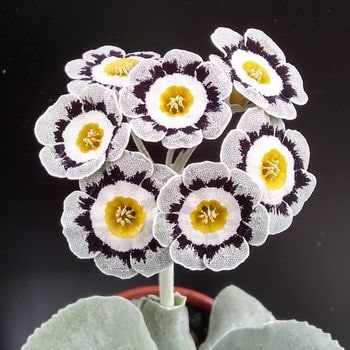A well grown Gold-laced Polyanthus is a gem of a flower, but sadly overlooked on the show bench they are not as popular as they once were.
-min.jpg)

The GLP grown to a single stem, is a true florist flower complying to written standards and may only be exhibited as thrum-eyed (stigma below the stamens). They may also be grown for effect and exhibited in the multi-stemmed GLP classes where either pin-eyed (stamen above stigma) or thrum-eyed are accepted.
All our shows have classes and trophies to be competed for, making them a challenging enough plant to be interesting and well worth pursuing.
Unlike the Auricula, it is virtually impossible to get named varieties of GLP. They tend to be grown under ‘strain’ names, each being developed by individuals. Old strains disappear and new ones come along, as such there is little use in looking for strains.
Obtaining quality show standard plants can be problematic, where available obtain plants that are flowering so as to see form .
Most GLPs are now grown as biennials, sowing seed one year and then maturing and flowering the following year. Most plants are then disposed of after flowering, however the best are then used to produce seed.
After showing or exhibiting, consider hybridising to produce your own seed. Cross only the best with the best; the brightest scarlets or crimsons and the deepest blacks. Don’t be tempted to cross red with black, it results in muddy colours which look inferior on the bench. Ideally cross a thrum-eyed to a thrum-eyed. If crossing onto a pin-eyed, the majority of resulting seedlings will be pin-eyed and unsuitable for exhibiting as a florist flower.
Growing from Seed
Harvest seed when mature and store in paper or glassine bags within a glass jam jar in the fridge (not freezer) until ready for sowing. Any surplus seed may be donated to the Society seed exchange.
Seeds are sown into a basic seed compost with a fine covering of the same, during February. Place into a polythene bag or similar to prevent drying out and keep out of full sun. Germination is approximately 14 days, prick out into seed trays when first true leaves appear. The seedlings grow quite quickly, initially 24 to a standard seed tray is adequate. When larger, move on to 15 to a tray or pot directly into 3.5” pots using a mix of 50% John Innes No 2 and 50% multi-purpose composts. Turn the plants weekly 180˚ thus preventing biased growth and a more balanced plant. Do not overfeed, the foliage will look fantastic, but the flowers will end up large resulting in a plant not as the standard requires.
The following February, things start to move. The foliage starts to actively grow and brighten. Ideally try to keep plants to a single crown of leaves. This is not always possible. If mature plants have been grown in a bed or a border, lift and pot up. As trusses start to form, select the strongest and remove others if intending to exhibit as a florist flower.
Growing from Mature Plants
Occasionally, a good plant can be used as a perennial. It will require splitting if it is to be exhibited in the florist section the following year, the crown requires cutting, but the roots prefer being torn apart. After potting up, keep cool and in semi-shade. Don’t over-water or losses will be high.
Alternatively it can be grown on as a large plant allowing benching in the multi-stemmed classes the following year. GLP dislike greenhouse cultivation during summer. Semi-shade and cool conditions are favourable, but if grown in the open avoid overhanging trees.
General Plant Care
Pests such as greenfly, root aphid, vine weevil and slug damage (if grown in an open bed) should be dealt with immediately.
Don’t grow in the greenhouse during summer months. A cold frame or a border is fine.
Over and under watering, full sun and excessive heat should be avoided.
On the eve of a show, clean pots, remove dead leaves, check the fully open pips and remove inferior pips, remembering five are required as a minimum in the open classes and three for Novice classes.

